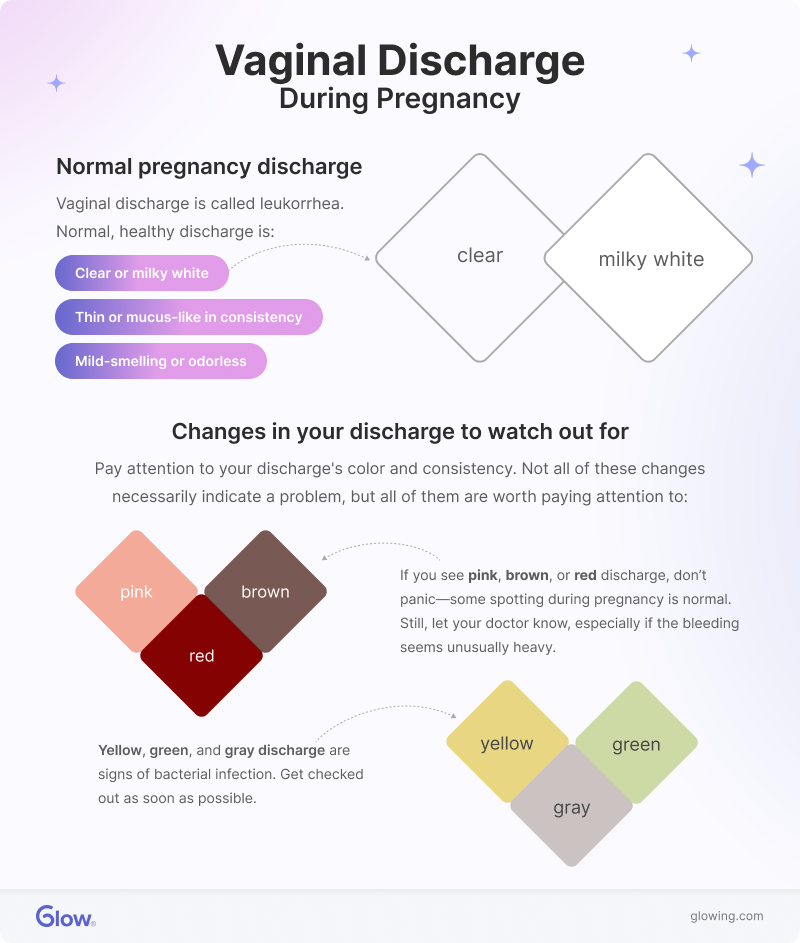What to Know About Vaginal Discharge During Pregnancy
Vaginal discharge is usually normal during pregnancy, and it generally isn’t anything to worry about, but certain changes in it can be of concern.

As you’re probably well aware, a lot happens to your body during pregnancy. With so many symptoms to keep track of, every soon-to-be mom needs to know what’s normal and what’s not—not only for your baby’s safety but also for your own peace of mind.
One big change you might notice is more vaginal discharge than you’re used to. While discharge is usually no big deal, you’ll need to keep an eye on it and make sure you know when it’s time to speak with your doctor.
Learn what causes pregnancy discharge, how to manage it, and when it means you should get medical attention.
What causes pregnancy discharge?
The short answer is that pregnancy discharge is caused by hormonal changes.
When you’re pregnant, your hormones send signals to your body to produce more discharge. This protects your birth canal from infection as your cervix and vaginal walls soften in preparation for childbirth. 1
The watery discharge you’ll see during early pregnancy is a mix of cervical and vaginal secretions, old cells, and normal bacteria. Many women find that the closer they get to their due date, the more discharge they produce.
What does normal pregnancy discharge look like?
Vaginal discharge is called leukorrhea. Normal, healthy discharge is:
- Clear or milky white
- Thin (but not watery) or mucus-like in consistency
- Mild-smelling or odorless
In general, you don’t need to worry if the amount of discharge you have changes as your pregnancy progresses. This is usually nothing to worry about unless you see one or more of the signs in the next section.
When should you be concerned about discharge?
While vaginal discharge is a normal part of pregnancy, some changes in your discharge could signal a problem. Here’s what you should look out for: 2
- Green or yellow discharge: If you’re sexually active, this may point to a sexually transmitted infection (STI), such as chlamydia. 3
- Gray discharge: This kind of discharge—especially when accompanied by a strong fishy odor that gets worse after sex—could mean you have a bacterial vaginosis (BV) infection. 4
- Brown discharge: This often indicates old blood and has various potential causes, including subchorionic hemorrhage and implantation bleeding. It’s likely nothing to be worried about, especially in early pregnancy. Still, inform your OB to be safe, especially if it is persistent.
- Pink discharge: Pink discharge, which indicates the presence of fresh blood, is also common (especially in early pregnancy or near labor). However, it’s also sometimes associated with complications, so talk to your doctor when this happens.
- Smelly discharge: A strong, foul, or fishy odor isn’t normal and could mean that you have an infection.
- White and lumpy discharge: White and lumpy discharge that looks like cottage cheese could mean that you have a yeast infection.
- Red (bloodier) discharge: If you have this (especially if it’s heavy), along with clots, pain, or cramping, seek treatment immediately. Red discharge can be a sign of a miscarriage or another serious complication, such as an ectopic pregnancy.
In addition, watch out for symptoms such as:
- Itching
- Burning
- Redness or swelling in your genitals
- Pain during urination or intercourse
Essentially, just do your best to listen to your body. Get in touch with your doctor if anything feels off, even if you’re not sure. There’s no such thing as being too careful when it comes to your health and your little one.
Is discharge a sign of preterm labor?
A change or increase in vaginal discharge isn’t usually a sign of preterm labor. However, some changes can signify infections which can lead to other complications. 5
If a change in your discharge is accompanied by symptoms such as menstrual-style cramps, contractions (especially more than four in an hour), and pressure in the lower belly, these could mean you’re going into preterm labor, so contact your doctor immediately. 6
What does it mean if your discharge is accompanied by heavy bleeding?
If you’re getting persistent heavy bleeding (i.e., requiring the use of pads or featuring the presence of clots) with your discharge, it could indicate (depending on how far along you are in your pregnancy):
- Miscarriage: This is most likely in early pregnancy; although different types of miscarriages can occur later, the majority occur in the first trimester.
- Preterm labor or delivery: Later on, heavy bleeding sometimes means that you’re at risk of going into labor before you were due.
- Placenta previa: This means your baby’s exit from your vagina is fully or partly blocked by the placenta. This is typically diagnosed during pregnancy ultrasounds.
- Placental abruption: This means your placenta has detached from your uterus ahead of schedule (before birth).
If you’re experiencing heavy bleeding, you may hear your doctor throw around the term threatened miscarriage (particularly in early pregnancy). This scary-sounding piece of jargon doesn’t necessarily mean you will have a miscarriage, but it does mean that your symptoms are concerning and statistically put you at higher risk of experiencing one. That, in turn, means you may need extra medical attention to have the best possible chance of completing your pregnancy successfully.
The upshot is that if you have heavy bleeding, you should get yourself to the doctor right away so that they can assess the situation and help.

How to manage your discharge
Here are a few tips to manage your vaginal health during pregnancy and keep your leukorrhea as healthy as possible:
- When you go swimming, work out, or take a shower, make sure to dry your genital area thoroughly. Change out of swimwear or wet or sweaty clothes as soon as possible.
- Don’t douche (i.e., flush out your vagina with water or cleansers). This is a common practice, but it upsets the natural balance of bacteria in your vagina, making you more prone to infection. Most doctors recommend against douching even if you’re not pregnant. 7
- Wear comfortable and breathable clothing and underwear. Keep tight-fitting pants and synthetic clothing in your closet for now, since these can trap moisture and cause irritation.
- Use unscented personal care products, including laundry detergent, soap, panty liners, and toilet paper.
- When managing particularly heavy discharge, you can use panty liners. Don’t use tampons when you’re pregnant unless your doctor says it’s OK.
- Monitor your discharge and keep your OB informed about it. If your discharge changes, don’t self-treat; always seek advice from your doctor.
Note that the CDC also recommends pregnant women get tested for certain STDs (including but not limited to chlamydia) at least twice during pregnancy to avoid passing on the infection to their babies. 8
What’s the difference between discharge, your mucus plug, and amniotic fluid?
As you get closer to your due date, your discharge will tend to get heavier as your pregnancy progresses. What’s more, as you near the finish line, you will also have to contend with your mucus plug and amniotic fluid.
Mucus plug
Around week 37 of your pregnancy, you might see streaks of thick mucus, sometimes with a bit of blood (which is known as “bloody show”). 9 This is your mucus plug—a thick, jelly-like glob that blocks the cervix to protect your baby.
As you approach your due date, this plug will dislodge. That isn’t anything to worry about. It happens to all women, and it’s a once-per-pregnancy affair.
It doesn’t necessarily mean that you will go into labor imminently. You can typically discuss it during your routine OB visit unless you’re also experiencing other symptoms, such as regular, painful cramps or contractions, vaginal fluid, or if you think you broke your water (see below).
Amniotic fluid
There’s yet another type of fluid that you may discharge right at the end of your pregnancy: amniotic fluid, which cushions your baby in your uterus.
This will leak continuously after your water breaks. It will be clear or slightly yellow, watery, and odorless or sweet-smelling. If you think your water broke, call your doctor or midwife immediately.
Final thoughts
It’s understandable if you were alarmed by an increase in your vaginal discharge, but just to reiterate, most of the time, that doesn’t mean you necessarily have a serious problem.
In fact, as long as it doesn’t develop an unusual texture, color, or smell, it’s a sign that you can rest easy. Your body is doing exactly what it’s supposed to. However, to be on the safe side, always bring up any questions or concerns to your doctor.
Article Sources
- Obstetrics and Gynecology International. "Pathological Vaginal Discharge among Pregnant Women: Pattern of Occurrence and Association in a Population-Based Survey" Retrieved April 14, 2025.
- Cleveland Clinic. "Vaginal Discharge Color: What’s Normal and What Isn’t" Retrieved April 14, 2025.
- National Health Service. "Trichomoniasis" Retrieved April 14, 2025.
- Keck Medicine of USC. "What You Need to Know About Vaginal Discharge" Retrieved April 14, 2025.
- MedlinePlus. "Common symptoms during pregnancy" Retrieved April 14, 2025.
- Cedars-Sinai. "Preterm Labor" Retrieved April 14, 2025.
- American College of Obstetricians and Gynecologists. "Is it safe to douche during pregnancy?" Retrieved April 14, 2025.
- Centers for Disease Control and Prevention. "Screening Recommendations and Considerations Referenced in Treatment Guidelines and Original Sources" Retrieved April 14, 2025.
- Cleveland Clinic. "Mucus Plug" Retrieved April 14, 2025.







